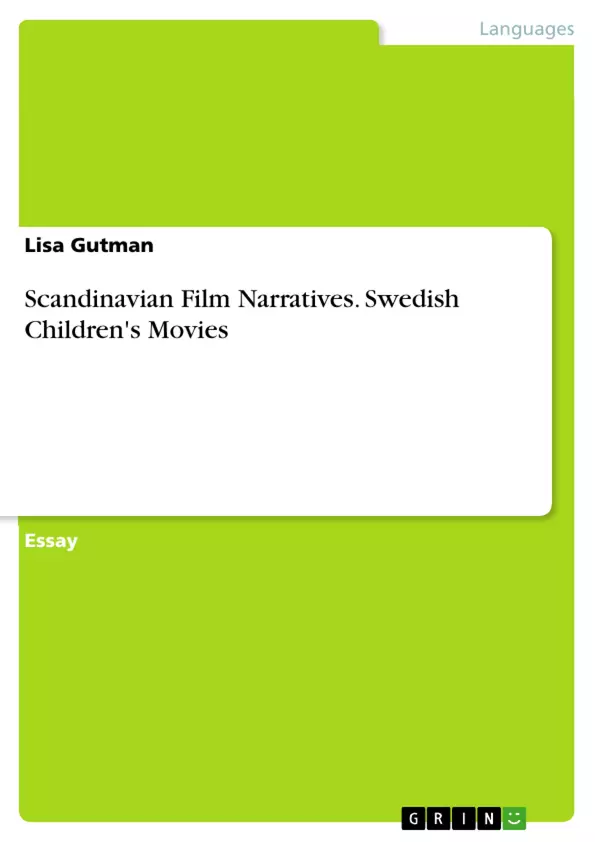This essay explores if there is a ‘typical’ Scandinavian film, and how Mio in the Land of Faraway relates to it.
Typical formal aspects of the fantasy for children genre is the harsh contrast between ordinary urban surroundings, where adults rule and children are suppressed and the magical land, where animals and objects can have strong enchanted properties and therefore nature is a power to reckon with.
Inhaltsverzeichnis (Table of Contents)
- Mio in the Land of Faraway: A Modern Take on a Classic
- Scandinavian Children's Films: A Traditional Setting
- The Importance of Nature and Community
- Mio in the Land of Faraway: A Modern Perspective
Zielsetzung und Themenschwerpunkte (Objectives and Key Themes)
This text examines the film adaptation of Astrid Lindgren's novel "Mio, My Mio", titled "Mio in the Land of Faraway," and analyzes its place within the broader landscape of Scandinavian children's films. The main objective is to explore how the film deviates from the traditional themes and settings typically associated with Swedish children's cinema, particularly those rooted in Astrid Lindgren's works.
- The film's departure from traditional Scandinavian children's film tropes
- The significance of nature and community in Scandinavian children's cinema
- The portrayal of modern urban life and its impact on children's experiences
- The role of fantasy and folklore in shaping the film's narrative
- Astrid Lindgren's legacy and her influence on Swedish culture
Zusammenfassung der Kapitel (Chapter Summaries)
- Mio in the Land of Faraway: A Modern Take on a Classic: This chapter introduces the film "Mio in the Land of Faraway" as a cinematic adaptation of Astrid Lindgren's popular novel. It highlights the film's themes of fantasy, adventure, and the triumph of good over evil, drawing parallels to fairy tales and folklore. The chapter also discusses the film's visual contrast between the urban setting of Stockholm and the magical kingdom of Faraway, highlighting the film's exploration of children's emotional journeys.
- Scandinavian Children's Films: A Traditional Setting: This chapter delves into the characteristics of Scandinavian children's films, emphasizing the dominant themes of nature, community, and nostalgia for a bygone era. Astrid Lindgren's works, particularly those featuring Pippi Longstocking, are highlighted as influential examples of this genre. The chapter argues that these films typically present children in secure and idyllic settings, emphasizing a sense of safety and belonging.
- The Importance of Nature and Community: This chapter further explores the significance of nature and community in Scandinavian children's films, drawing connections to Astrid Lindgren's emphasis on children's autonomy and their need for a sense of belonging. The chapter also touches upon the contemporary relevance of these themes in a society increasingly dominated by urban life and technological advancement.
- Mio in the Land of Faraway: A Modern Perspective: This chapter examines how "Mio in the Land of Faraway" departs from the traditional themes and settings of Scandinavian children's films. It explores the film's portrayal of modern urban life, focusing on the challenges faced by children in contemporary society, such as bullying, neglect, and parental divorce. The chapter suggests that the film's more contemporary approach might explain the negative reception it received in Swedish newspapers.
Schlüsselwörter (Keywords)
This text focuses on the analysis of the film "Mio in the Land of Faraway" and its relationship to Scandinavian children's films. Key terms include: fantasy film, Astrid Lindgren, Scandinavian cinema, children's films, urban environment, nature, community, nostalgia, traditional settings, modern perspective, and cultural heritage.
- Quote paper
- Lisa Gutman (Author), 2014, Scandinavian Film Narratives. Swedish Children's Movies, Munich, GRIN Verlag, https://www.grin.com/document/349148



